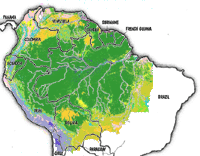

135,000 years ago, during the previous warm spell, the oceans rose 10 to 30 feet higher than today. So why would anyone expect the oceans not to be rising today? We should expect much more melting ice and rising water, based on past history. It’s reckless to put the blame on human activity. | |||||||
| The warm spells are a little different each time, but it would be best to assume more rising water and disappearing glaciers, and to assume that will be followed by cold and glacier advance. Most likely, the polar bears are going to starve, and the pacific atolls are going to flood. Maybe all the coastal cities will be under water. We should expect the glacier melting process to be accelerating right now because the loss of surface albedo (reflectivity). The more ice that is lost, the faster it will be lost. There might be a human global warming effect, but don’t count on it. The Earth’s temperature fluctuates, or there are local fluctuations, or hemispherical fluctuations. The world was warm during the early 13th century. Grapes grew in England. Then came the Little Ice Age. Priests prayed for the glaciers to stop their terrifying advances. Ice ground up towns. Millions starved to death. Remember the movie “Sink the Bismarck”? That battleship and the pursuing cruisers steamed through the Straights of Denmark. That couldn’t happen if they were back the little ice age -- that ocean was frozen solid. In the war of 1812, heavy cannons were rolled across the frozen East river (NYC). There were snow flurries in Savannah, Georgia in August. Now it’s warm. The temperature can change from hot to cold in fifty years or less, through no fault of man. Global warming scientists are worried about melting ice in southern Greenland. Think about how Greenland got it’s name -- it was green when explorers named it. | |||||||
| The Fox News global warming special on 5-21-06 said the next ice age won’t begin for the next 50,000 - 100,000 years. Where did they get that? Look at the past record and decide what’s the next most likely event. The best evidence is that the current warm spell is ending. They also said that world has been warming since the little ice age -- true enough, but there has been a general cooling trend ever since the Holocene Maximum, with only smaller temperature fluctuations (the Holocene Interglacial is the name of the current warm period, and the warmest point, the Holocene Maximum, occurred 5,500 years ago). 2-19-07: See also the “predictions” page (last paragraph). Just 5,500 years ago, at the Holocene Maximum, the world’s oceans were 6 - 10 feet higher than today. The coastlines were different; the land was smaller. That means much more ice was melted 5,500 years ago; the glaciers were much smaller than today. Then there was a 2,500 year cold spell (much colder than the little ice age) and the glaciers grew larger and the sea level fell 6 -10 feet lower. 3000 years ago the world began to warm again, and it stayed warm until the 1300’s. Below is a chart of Holocene temperatures (freehand to avoid copyright issues).
| |||||||
 | |||||||
| The graph above marks the rise and fall of civilizations and the transformation of the planet’s geography -- and this is during the supposedly tranquil warm period when civilization developed. The Holocene Maximum marks the end of savanna-like conditions in North Africa, and the beginning of the Sahara desert as we know it. Lakes and rivers dried up, elephants and rhinos vanished, and a large population of mankind and its domesticated animals migrated or perished. The cold spell that followed marked the decline of the old kingdom in Egypt (the pyramid builders), and the decline of the Harappan culture in India, among others. The little ice age caused the dark ages in Europe. The above curves are of polar temperature change, and are shown as smooth curves, but remember, climate changes daily and yearly. There are “years without summers” and cold dry centuries hidden in the above curves, as well as warm days during cold spells, and cold days during hot spells. Al Gore’s movie predicts the coastline of a new, smaller Florida one hundred years from now. He neglects to say that was the coastline of Florida just 5,500 years ago, and humans didn’t cause that. |

